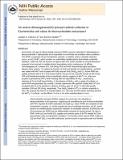An active dimanganese(III)-tyrosyl radical cofactor in Escherichia coli class Ib ribonucleotide reductase
Author(s)
Cotruvo, Joseph A.; Stubbe, JoAnne
DownloadStubbe_An active.pdf (902.5Kb)
PUBLISHER_POLICY
Publisher Policy
Article is made available in accordance with the publisher's policy and may be subject to US copyright law. Please refer to the publisher's site for terms of use.
Terms of use
Metadata
Show full item recordAbstract
Escherichia coli class Ib ribonucleotide reductase (RNR) converts nucleoside 5′-diphosphates to deoxynucleoside 5′-diphosphates and is expressed under iron-limited and oxidative stress conditions. This RNR is composed of two homodimeric subunits: α2 (NrdE), where nucleotide reduction occurs, and β2 (NrdF), which contains an unidentified metallocofactor that initiates nucleotide reduction. nrdE and nrdF are found in an operon with nrdI, which encodes an unusual flavodoxin proposed to be involved in metallocofactor biosynthesis and/or maintenance. Ni affinity chromatography of a mixture of E. coli (His)[subscript 6-]NrdI and NrdF demonstrated tight association between these proteins. To explore the function of NrdI and identify the metallocofactor, apoNrdF was loaded with Mn[superscript II] and incubated with fully reduced NrdI (NrdI[subscript hq]) and O[subscript 2]. Active RNR was rapidly produced with 0.25 ± 0.03 tyrosyl radical (Y·) per β2 and a specific activity of 600 units/mg. EPR and biochemical studies of the reconstituted cofactor suggest it is Mn[superscript III][subscript 2-]Y·, which we propose is generated by Mn[superscript II][subscript 2-]NrdF reacting with two equivalents of HO[subscript 2]−, produced by reduction of O[subscript 2] by NrdF-bound NrdI[subscript hq.] In the absence of NrdI[subscript hq], with a variety of oxidants, no active RNR was generated. By contrast, a similar experiment with apoNrdF loaded with Fe[superscript II] and incubated with O[subscript 2] in the presence or absence of NrdI[subscript hq] gave 0.2 and 0.7 Y·/β2 with specific activities of 80 and 300 units/mg, respectively. Thus NrdI[subscript hq] hinders Fe[superscript III][subscript 2-]Y· cofactor assembly in vitro. We propose that NrdI is an essential player in E. coli class Ib RNR cluster assembly and that the Mn[superscript III][subscript 2-]Y· cofactor, not the diferric-Y· one, is the active metallocofactor in vivo.
Date issued
2010-01Department
Massachusetts Institute of Technology. Department of Biology; Massachusetts Institute of Technology. Department of ChemistryJournal
Biochemistry
Publisher
American Chemical Society (ACS)
Citation
Cotruvo, Joseph A., and JoAnne Stubbe. “An Active Dimanganese(III)−Tyrosyl Radical Cofactor in Escherichia Coli Class Ib Ribonucleotide Reductase.” Biochemistry 49.6 (2010): 1297–1309.
Version: Author's final manuscript
ISSN
0006-2960
1520-4995